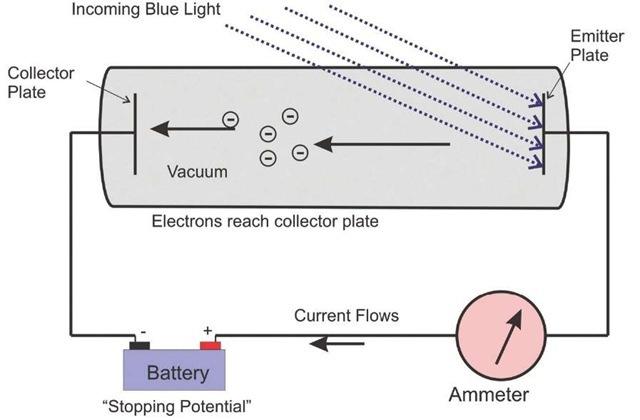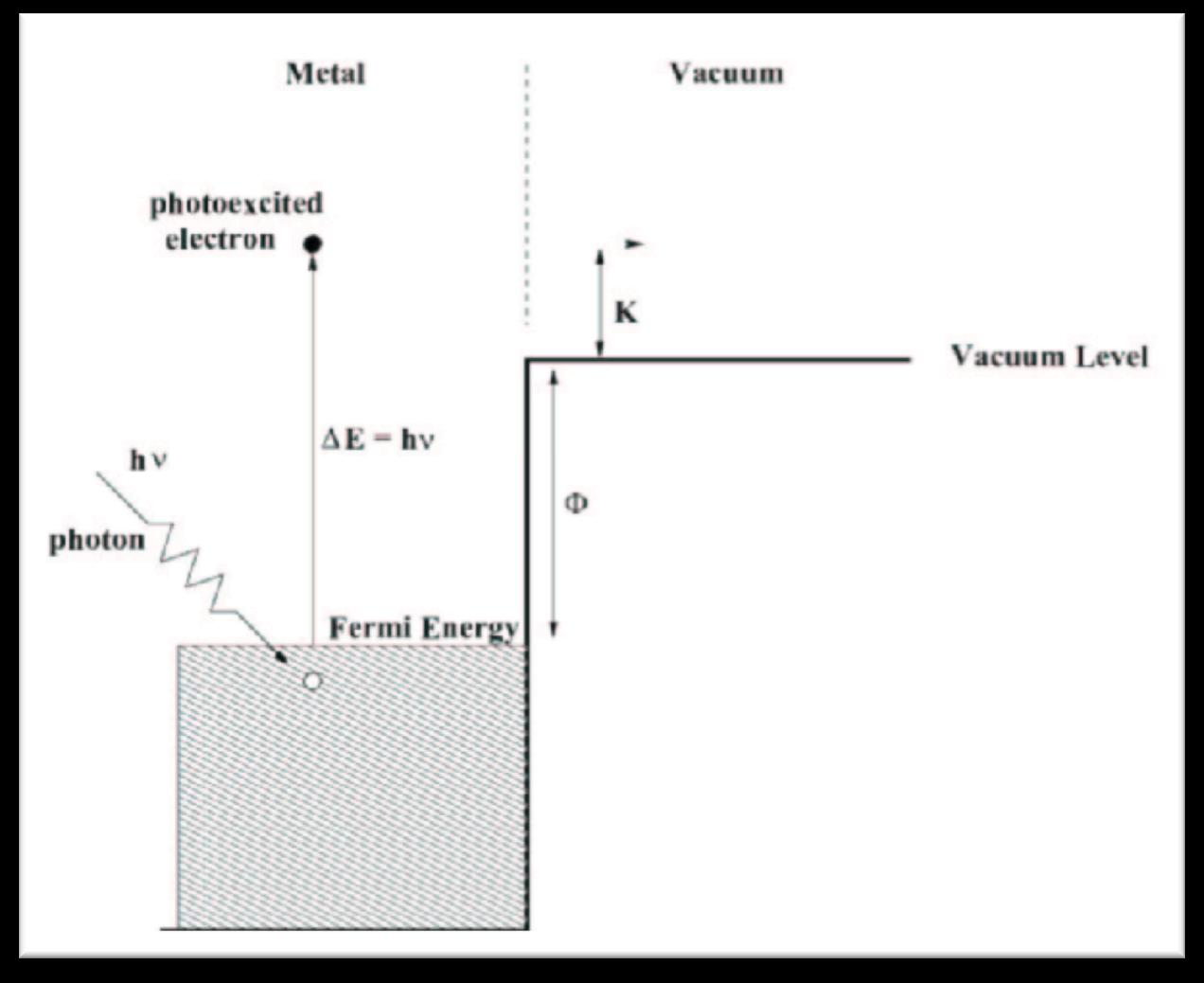Proving the Work Produced by Light
Author: David Eduardo ToroAffiliations:1 Florida Institute of Technology, Melbourne, Florida (USA)
Abstract: In this paper, I prove the mechanism of work produced by light on the electrons in a sodium metal cathode. Using solid state physics I derive Einstein’s work function of the sodium atom theoretically. Thus, I prove an extension of Einstein’s photoelectric effect by showing the mechanics of light as it interacts with electrons in matter. Two experimental setups back up the results.
In a sinusoidal signal. The acceleration that results is as follows.
x = A i Sin( wt )
dx dt = A i w i Cos( wt )
We can solve for the constant if we include the speed of light as the velocity of the signal.
A = c 2π f
d 2 y
dx 2 = A i w2 i sin( wt )
d 2 y
dx
Where the negative represents the inward acceleration of a signal of light. And we will show theoretically and experimentally that light produces acceleration.
The work produced by light is (mass times acceleration times distance):
m i a i x = m i ( 2π fc ) i x
if we substitute for the frequency in the acceleration term:
E = hf = mc 2
f = mc 2 h
Another way to express the acceleration:
a = 2π fc
a = 2π mc 3 h
If we equate the gravitational energy to the lights work function we can independently derive the Planck length. Which corresponds to the smallest length possible for a single photon. Notice that the photon has gravitational energy and this energy does work on other signals.
Light Work is Gravitational in extent:
GMm r = m2π fcx
Deriving the Planck Length:
x = r x 2 = GM fc i 2 i π M = hf c 2
PlanckLength = Gh 2π c 3
Similar use of this equation can derive the planck time, planck mass, and planck energy.
Using experimental data of the Photoelectric Effect to prove the validity of a photons work on electrons in a sodium cathode.
Einstein developed an experiment to determine the energy in light. When monochromatic light is beamed at an emitter plate he noticed that there was a current produced. If you apply a voltage in the opposite direction of the current we can cancel out the current.
Our experimental setup is titled “Photoelectric Effect Prelab” by Dr. Christine P Cheney of the Department of Physics and Astronomy from the University of Tennessee. [1]
With the experimental evidence that I am citing the current produced by the light is 0.071A in the circuit and the cathode is made out of sodium metal

Fig 1. The Photoelectric effect. Light is beamed at the cathode made out of Sodium. A stopping potential is applied to stop the current.
We can derive an expression to explain the photoelectric effect using the photon’s work function and with consideration in solid state physics.
As we derived we notice that light pushes things backward
We can begin to derive the equation that describes the photoelectric effect, by first deriving all the terms of the equation. W photon = Elight E stopping potential + E Fermi Energy
Recall that the energy of light is expressed as follows:
Elight = hf
The energy required to stop the current from flowing is called the stopping potential and its expressed as follows
E stopping potential = qV
The total amount of work that the light performs to excite the electron from its ground state to its free state, with kinetic energy, is given by the photon’s Work Function. We can re-express the equation to eliminate the mass, of light, from the expression.
mc 2 = fh
m = fh c 2 = fh c 2 = fht 2 x 2 = ht x 2
W photon = 2π hc λ
The next term in our equation that we will be using was derived by Enrico Fermi. However, I found a mistake in his equation. And it’s important that we derive the mistake to explain the correction before we move on to explaining the experimental data.
The following is unit analysis:
E = mv 2
E = ML2T 2
ET 2 = ML2
ET = ML2T 1
ET = PL
h ⋅ f ⋅ T = PL
h = PL
The important part of this is that the solution derives planck constant. Not the Reduced planck constant, because that adds an extra 2pi that does not correspond to the unit analysis that we just described. This is an important distinction in the derivation.
For the Fermi Energy derivation, I took a look at the Introduction to Solid State Physics by Charles Kittel [2]. I studied the free electron gas in three dimensions.
The following is the Fermi Energy with a correction.
Recall that:
E = p 2 2 m = 1 2 mv 2
h = PL
h 2 = P 2 L2
L = 2π
L2 = 2π ( )2
We remove the reduced planck constant to correct the derivation.
Thus, the Fermi energy is as follows.
Now we can derive the equation that will describe the Photoelectric Effect as Follows.
On the left, we have the photons work function, which represents all the Work light does on the electrons in the photoelectric effect.
The first term on the right side represents the kinetic energy the light will gain after it satisfied the potential energy required to reach the unbound state. This produces the kinetic energy associated with the current.
The next term is the stopping potential. This is the experimental voltage used to stop the flow of current. At the instance where the stopping potential stops the current, this corresponds to the maxed-out Fermi Energy.
And the last term, the Fermi Energy, is the Potential energy. It’s the energy difference between the highest and lowest occupied particle state occupied by the electrons.

Fig. 2: This schematic shows a ray of light exciting the electron in a Sodium atom. The light does work on the electron to fill the Fermi Energy potential energy. This is the energy associated with the energy required to go from the ground state to the highest occupied state. If there is any energy left the electron gains Kinetic Energy E=hf.
The next thing we need to do is to find all the experimental values for the Number of electrons divided by the volume they occupy, the number density of free electrons. 2π hc
o hf + qV
2π hc λ o hf + qV
The first thing we want to do is calculate the Number Density of free electrons. The reason we can figure this number out experimentally is that when we stop the voltage we cancel out the kinetic energy produced by the incident light and we fill the Fermi Energy level to its highest level
f = 7.49481145 1014 hz
λ = 400 ⋅ 10 9 m
q = 1.602176634 ⋅ 10 19 Coulomb
h = 6.62607004 10 34 m 2 kg / s
Vstopping = 0.72Volts
c = 299, 792, 458
m e = 9.1093837015 ⋅ 10 31 kg
N V = 2π hc
Plugging in all of these variables gives us the electron density.
N V = 1.29416 10 27 electrons / m 3
To derive what Einstein called the Work Function [3] theoretically we need to calculate the total work that light does on the electrons and subtract the Fermi Energy.
When we subtract the total work done by the light minus the fermi energy (when the stopping voltage is applied) we get the energy associated with the electrostatic attraction of the sodium protons on the electrons. It’s what Einstein called the work function.
If we solve for the work function using the calculated Number Density and the light at 400nm. We get a theoretical value for Einstein’s Work Function of 2.36 Ev [4]. The experimental value for the work function is 2.38 eV . Since we know the cathode in the experiment is made out of sodium - the work function matches. Thus, we proved Einstein’s Work Function to be correct with a 0.85% error.
ϕExperimental = 2.38eV ϕ
If we increase the frequency and stop the stopping potential voltage, the equation simplifies to Einstein’s Photoelectric effect equation.
We can verify the stoping voltage as follows
Ek = hf ϕ
If we increase the frequency and stop the stopping potential voltage the electrons will gain kinetic energy.
Ek = hf ϕ hf = (6.62607004 10 34 m 2 kg / s )
ϕ = 2.38ev = 2.38eV ( ) i 1.602176634 ⋅ 10 19 C ( ) = 3.813180389 ⋅ 10 19 Joules
E K = 4.96611456 ⋅ 10 19 J 3.813180389 ⋅ 10 19 Joules = 1.152934171 ⋅ 10 19 Joules
Using the current equations we can derive the stopping voltage to be accurate. And thus we conclude that the light’s work function does yield the right result. And the experimental setup has the correct energy for the stopping potential.
The power is given by the current times the voltage.
P = iV
E t = q t V
E = qV
V = E q
V = E q = 1.152934171 ⋅ 10 19 Joules 1.602176634 ⋅ 10 19 C
Ek = hf ϕ qV = 0
Thus the photoelectric effect yields the behavior of light.
An additional experiment at the National Institute for Standards and Technology (NIST) found that light hitting a metal surface at an angle sends the electrons moving in the opposite direction opposite to light.[5][6] This confirms the results in two separate experiments.
References:
1. Dr. Christine P Cheney, Photoelectric Effect Prelab, http://www.phys.utk.edu/labs/Photoelectric%20Effect%20Prelab.pdf
2. Charles Kittel, November 11th, 2004, Introduction to Solid State Physics
3. Albert Einstein, 1905, On a Heuristic point of view concerning the production and transformation of light.
4. https://public.wsu.edu/~pchemlab/documents/Work-functionvalues.pdf
5. Jared H Strait et al. 2019 Revisiting the Photon-Drag Effect in Metal films Physical Review Letters DOI: 10.1103/PhysRevLett/123.053903
6. https://physics.aps.org/articles/v12/88
